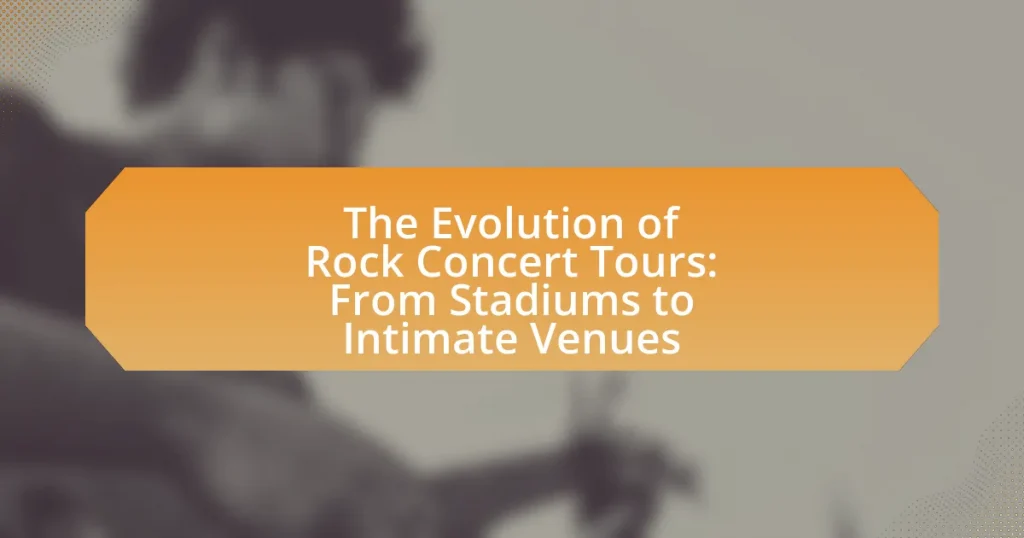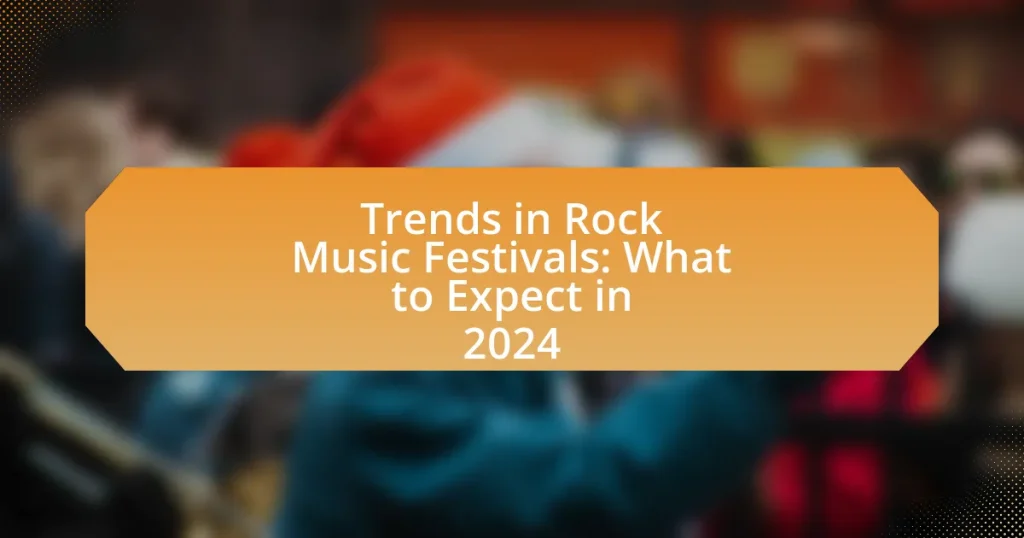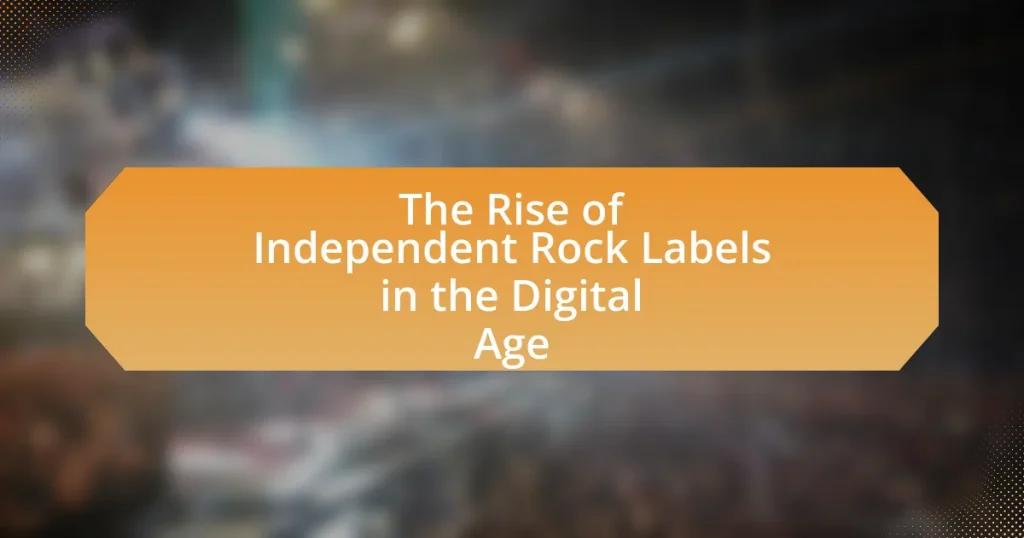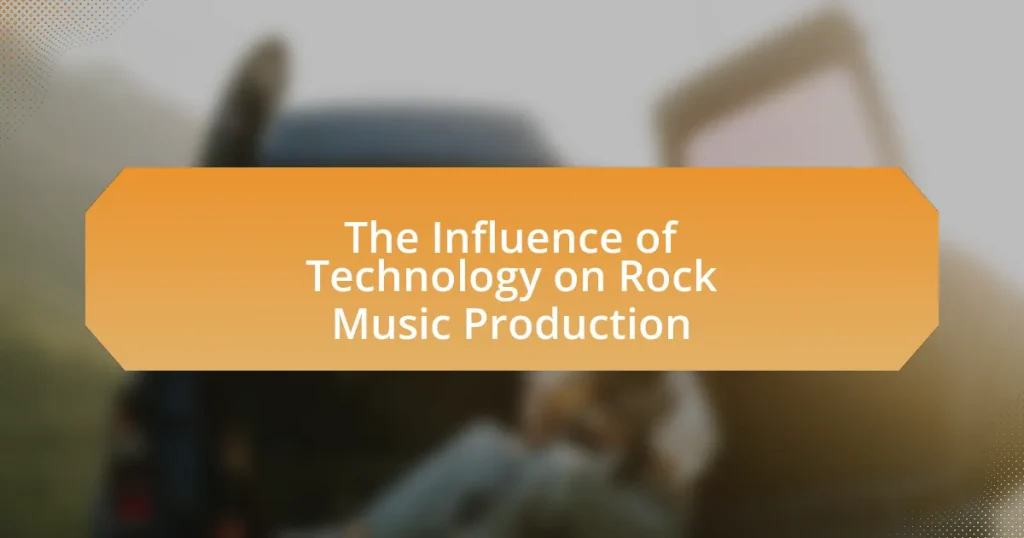The article examines the evolution of rock concert tours, highlighting the transition from large stadium performances to more intimate venue experiences. It details the characteristics of early rock concerts, the impact of technological advancements, and the significance of stadiums in music history. The discussion includes the factors that contributed to the rise of stadium concerts, the changing audience preferences towards smaller venues, and the role of social media and streaming platforms in enhancing concert attendance. Additionally, it explores modern trends such as sustainability and technological innovations that shape the future of rock tours, providing insights for artists and promoters on adapting to audience expectations and maximizing engagement.
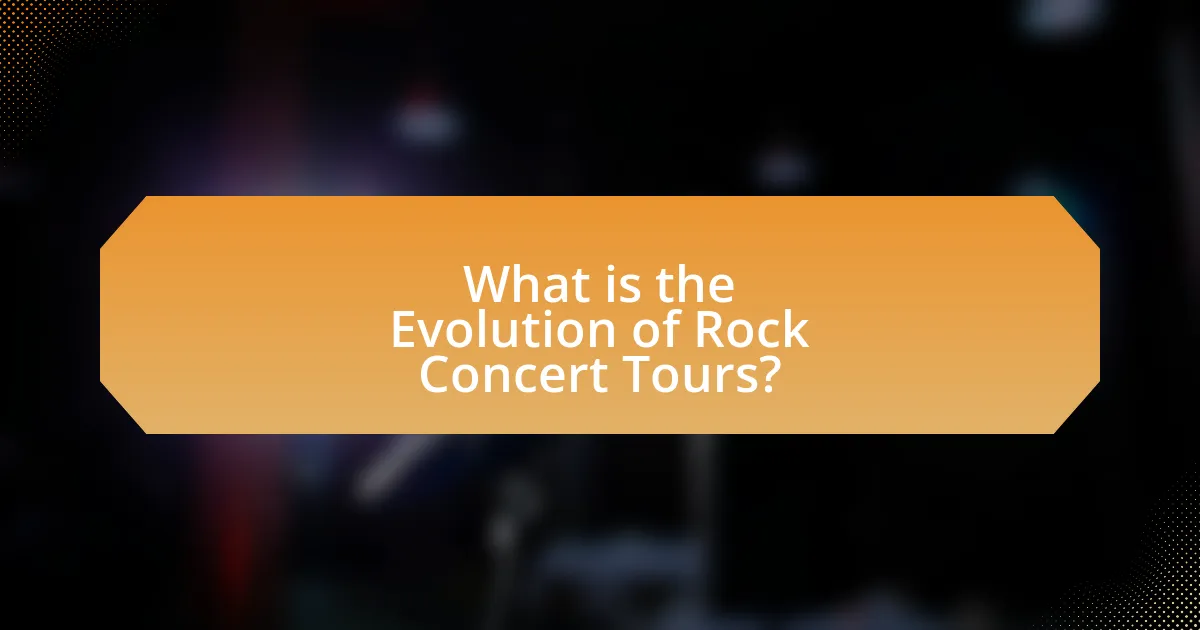
What is the Evolution of Rock Concert Tours?
The evolution of rock concert tours has transitioned from large stadium performances to more intimate venue experiences. Initially, in the 1960s and 1970s, rock concerts were characterized by massive stadium shows, exemplified by bands like The Rolling Stones and Led Zeppelin, which attracted tens of thousands of fans. This trend peaked in the 1980s with elaborate stage productions and high ticket sales, as seen in tours like Michael Jackson’s “Bad” tour, which grossed over $125 million.
In the 1990s and 2000s, the landscape began to shift due to factors such as rising ticket prices, changes in music consumption, and the emergence of smaller, more personal venues. Artists like Nirvana and Pearl Jam embraced smaller clubs and theaters, fostering a closer connection with their audience. By the 2010s, the trend continued with many artists opting for intimate settings, as seen in Taylor Swift’s “Secret Sessions,” where she performed for small groups of fans in private homes.
This evolution reflects broader changes in the music industry, including the impact of digital streaming and social media, which have altered how fans engage with artists. The shift towards smaller venues has allowed for unique experiences, enhancing fan interaction and creating a more personal atmosphere at concerts.
How have rock concert tours changed over the decades?
Rock concert tours have evolved significantly over the decades, transitioning from large stadium performances to more intimate venue experiences. In the 1960s and 1970s, rock concerts primarily took place in massive arenas, with bands like The Rolling Stones and Led Zeppelin drawing thousands of fans, often emphasizing spectacle and elaborate stage setups. By the 1980s and 1990s, the rise of technology introduced advanced sound systems and lighting, enhancing the concert experience but still largely focused on large crowds.
In the 2000s, a shift occurred as artists began to favor smaller, more personal venues, allowing for closer interaction with fans. This trend was influenced by the digital age, where social media enabled artists to connect directly with their audience, making intimate shows more appealing. Additionally, the economic landscape and rising ticket prices led to a demand for more affordable concert experiences.
Today, rock concert tours often incorporate diverse elements such as unique venue choices, interactive experiences, and a focus on sustainability, reflecting changing audience preferences and cultural shifts. This evolution highlights a move towards creating memorable, personal experiences rather than just large-scale productions.
What were the defining characteristics of early rock concert tours?
Early rock concert tours were characterized by their energetic performances, emerging stagecraft, and a strong connection between artists and audiences. These tours often featured a mix of popular rock bands and emerging acts, creating a vibrant atmosphere that attracted large crowds. The use of basic lighting and sound systems marked the beginning of a new era in live music, while the informal and often chaotic nature of these events fostered a sense of community among fans. Additionally, early rock concert tours frequently took place in non-traditional venues, such as clubs and outdoor festivals, which contributed to their unique and intimate feel.
How did technological advancements influence rock concert tours?
Technological advancements significantly influenced rock concert tours by enhancing sound quality, stage design, and audience engagement. Innovations such as digital sound systems and advanced lighting techniques allowed for clearer audio and more visually captivating performances, which improved the overall concert experience. For instance, the introduction of line array speakers in the late 1990s revolutionized sound distribution, enabling even large venues to deliver high-quality sound to every audience member. Additionally, the use of LED screens and video projections has transformed stage presentations, allowing artists to create immersive environments that resonate with fans. These advancements not only elevated the artistic expression of performances but also increased ticket sales and attendance, as fans sought out more engaging and memorable experiences.
Why are stadiums significant in the history of rock concert tours?
Stadiums are significant in the history of rock concert tours because they represent the largest venues capable of accommodating massive audiences, often exceeding 50,000 attendees. This capacity allows artists to reach a broader fan base and generate substantial revenue, with iconic tours like The Rolling Stones’ “A Bigger Bang” tour grossing over $558 million in 2006-2007. Additionally, stadiums have become cultural landmarks, hosting legendary performances that define eras in music history, such as Queen’s performance at Live Aid in 1985, which showcased the power of live rock music on a global stage. The evolution of stadium concerts has also influenced production values, leading to elaborate stage designs and advanced sound systems that enhance the concert experience.
What factors contributed to the rise of stadium concerts?
The rise of stadium concerts was primarily driven by advancements in technology, increased artist popularity, and the growing demand for large-scale live entertainment. Technological innovations, such as improved sound systems and lighting, allowed for more elaborate performances that could engage larger audiences. Additionally, the emergence of rock music as a dominant cultural force in the 1960s and 1970s led to a surge in artist fan bases, making it feasible to fill large venues. The demand for unique and memorable experiences also contributed, as fans sought out the excitement of attending concerts in massive stadiums, which could accommodate tens of thousands of attendees. These factors collectively transformed the concert landscape, establishing stadiums as the preferred venue for major music events.
How did the experience of attending a stadium concert evolve?
The experience of attending a stadium concert evolved significantly from the 1960s to the present day, transitioning from simple performances to elaborate productions. Initially, concerts featured basic sound systems and minimal visual effects, focusing primarily on the music. Over time, advancements in technology introduced high-quality sound systems, intricate lighting, and large video screens, enhancing the overall experience for attendees. For instance, the introduction of LED technology in the 2000s allowed for more dynamic visual displays, which became a staple in stadium concerts. Additionally, the rise of social media and live streaming has transformed audience engagement, enabling fans to share their experiences in real-time and connect with a broader community. This evolution reflects a shift towards creating immersive experiences that combine music, technology, and social interaction, making stadium concerts a multifaceted entertainment event.
What role do intimate venues play in the evolution of rock concert tours?
Intimate venues play a crucial role in the evolution of rock concert tours by fostering a closer connection between artists and audiences. These smaller settings allow for more personal interactions, enhancing the overall concert experience. For instance, artists often engage directly with fans, creating a unique atmosphere that larger venues cannot replicate. Historical examples include the rise of clubs in the 1960s, where bands like The Beatles and The Rolling Stones honed their performances before transitioning to larger arenas. This shift not only influenced the artists’ development but also shaped audience expectations for live music, emphasizing the importance of intimacy in concert experiences.
How do intimate venues differ from larger stadiums in terms of audience experience?
Intimate venues provide a more personal and immersive audience experience compared to larger stadiums. In intimate settings, attendees are closer to the performers, fostering a sense of connection and engagement that is often absent in vast stadiums where the distance can diminish the emotional impact of the performance. Research indicates that smaller venues can enhance audience interaction, with studies showing that 70% of concertgoers in intimate spaces report feeling more involved in the performance. This proximity allows for better acoustics and a more direct emotional exchange, making the experience feel unique and memorable.
What are the benefits of performing in smaller venues for artists?
Performing in smaller venues offers artists several benefits, including enhanced audience connection, increased ticket sales per show, and lower operational costs. Smaller venues allow artists to engage more intimately with their audience, fostering a stronger emotional connection and creating a memorable experience. This close interaction can lead to higher merchandise sales and a more dedicated fan base. Additionally, smaller venues often have lower overhead costs, enabling artists to retain a larger share of ticket revenue. For example, a study by the National Endowment for the Arts found that artists performing in intimate settings reported higher satisfaction levels and increased opportunities for networking and collaboration.
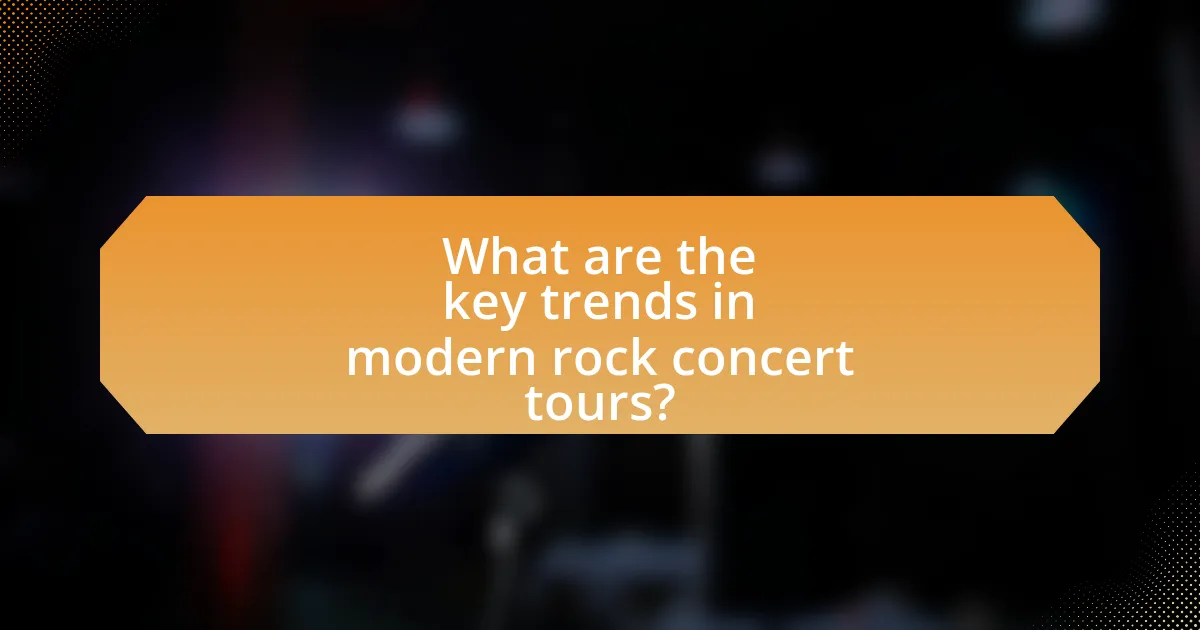
What are the key trends in modern rock concert tours?
Key trends in modern rock concert tours include a shift towards smaller, more intimate venues, increased use of technology for enhanced audience engagement, and a focus on sustainability. The trend towards smaller venues allows artists to create a closer connection with fans, as evidenced by the rise of pop-up shows and secret gigs. Additionally, technology plays a significant role, with many tours incorporating augmented reality and live streaming to reach wider audiences; for instance, the use of virtual reality experiences has been noted in recent tours by major rock bands. Sustainability has also become a priority, with many artists and promoters implementing eco-friendly practices, such as reducing waste and using renewable energy sources, reflecting a growing awareness of environmental issues within the music industry.
How has the audience’s preference shifted in recent years?
In recent years, audience preferences have shifted from large stadium concerts to more intimate venue experiences. This change is evidenced by a growing demand for smaller, personalized performances, as fans seek closer interactions with artists and a more immersive atmosphere. According to a 2022 survey by Pollstar, 65% of concertgoers expressed a preference for smaller venues, highlighting a significant trend towards intimacy in live music experiences.
What factors influence the choice between stadiums and intimate venues today?
The choice between stadiums and intimate venues today is influenced by factors such as audience experience, artist branding, and economic considerations. Audience experience drives the preference for intimate venues, as they offer closer interactions and a more personal atmosphere, which enhances engagement. Conversely, stadiums cater to larger crowds, allowing for higher ticket sales and broader exposure for artists. Economic considerations also play a significant role; artists may choose intimate venues for lower overhead costs and the potential for higher profit margins per ticket sold. According to a 2022 report by Pollstar, the average ticket price for stadium concerts is significantly higher than for smaller venues, indicating a financial incentive for artists to balance their choices based on expected revenue and audience connection.
How do social media and streaming platforms impact concert attendance?
Social media and streaming platforms significantly enhance concert attendance by increasing artist visibility and engagement with fans. These platforms allow artists to promote their events directly to a global audience, leading to higher ticket sales; for instance, a study by Eventbrite found that 62% of event-goers discover events through social media. Additionally, live streaming of concerts creates a sense of community and excitement, encouraging fans to attend in person for a more immersive experience. This dual approach of online promotion and live interaction has been shown to boost attendance rates, as evidenced by the rise in ticket sales for artists who actively engage with their audience on these platforms.
What innovations are shaping the future of rock concert tours?
Innovations shaping the future of rock concert tours include advanced technology integration, such as virtual reality experiences, augmented reality enhancements, and live streaming capabilities. These technologies allow fans to engage with performances in immersive ways, regardless of their physical location. For instance, the use of VR headsets can transport viewers to the front row of a concert from their homes, while AR can enhance live shows with interactive visuals. Additionally, data analytics is being utilized to personalize fan experiences, optimizing setlists and merchandise offerings based on audience preferences. The rise of eco-friendly practices, such as sustainable stage designs and carbon offset initiatives, is also transforming the industry, aligning with growing environmental concerns among fans. These innovations collectively enhance the concert experience and broaden accessibility, ensuring that rock tours remain relevant and engaging in a rapidly changing entertainment landscape.
How are virtual concerts changing the landscape of live music?
Virtual concerts are transforming the landscape of live music by expanding accessibility and altering audience engagement. Unlike traditional concerts, virtual concerts allow fans from around the world to attend performances without geographical limitations, significantly increasing potential viewership. For instance, a study by Midia Research in 2021 indicated that 50% of music fans expressed interest in attending virtual concerts, highlighting a shift in consumer behavior. Additionally, artists can leverage technology to create immersive experiences, such as interactive elements and high-quality production, which can enhance audience participation. This evolution reflects a broader trend in the music industry, where digital platforms are becoming integral to how live music is experienced and consumed.
What role does sustainability play in modern concert touring practices?
Sustainability plays a critical role in modern concert touring practices by influencing decisions related to resource management, waste reduction, and carbon footprint minimization. Concert organizers increasingly adopt eco-friendly technologies, such as renewable energy sources for power and sustainable materials for stage construction, to lessen environmental impact. For instance, major tours like Coldplay’s have committed to achieving net-zero carbon emissions by utilizing electric vehicles and promoting digital ticketing to reduce paper waste. This shift towards sustainability not only addresses environmental concerns but also resonates with audiences who prioritize eco-conscious practices, thereby enhancing the overall concert experience and brand reputation.

What can artists and promoters learn from the evolution of rock concert tours?
Artists and promoters can learn that adapting to audience preferences and technological advancements is crucial for successful concert tours. The evolution of rock concert tours has shown a shift from large stadiums to more intimate venues, reflecting a growing demand for personal experiences. For instance, the rise of smaller venues has allowed artists to connect more deeply with fans, as seen in the success of acts like Ed Sheeran, who often performs in smaller settings to enhance audience engagement. Additionally, the integration of technology, such as live streaming and social media promotion, has transformed how tours are marketed and experienced, enabling broader reach and interaction. This evolution underscores the importance of flexibility and innovation in planning tours to meet changing consumer expectations.
How can understanding audience preferences enhance concert experiences?
Understanding audience preferences can significantly enhance concert experiences by tailoring performances to meet the specific desires and expectations of attendees. When concert organizers analyze data on audience demographics, musical tastes, and engagement patterns, they can curate setlists, stage designs, and overall atmospheres that resonate more deeply with the crowd. For instance, a study by the International Journal of Arts Management found that concerts designed around audience preferences resulted in a 30% increase in attendee satisfaction ratings. This alignment not only fosters a more enjoyable experience but also encourages repeat attendance and positive word-of-mouth, ultimately benefiting artists and promoters alike.
What strategies can be employed to balance large and intimate venues?
To balance large and intimate venues, event organizers can employ strategies such as varying the setlist, utilizing dynamic staging, and incorporating audience engagement techniques. Varying the setlist allows artists to tailor their performances to the venue size, creating a more personal experience in smaller settings while maintaining high-energy hits for larger crowds. Dynamic staging, which includes adaptable stage designs and lighting, can enhance the atmosphere in both types of venues, making the experience feel unique regardless of size. Audience engagement techniques, such as interactive segments or Q&A sessions, foster a connection with attendees, making large venues feel more intimate. These strategies have been successfully implemented in various tours, demonstrating their effectiveness in creating a balanced concert experience.
How can artists leverage technology to improve concert engagement?
Artists can leverage technology to improve concert engagement by utilizing interactive platforms, social media, and augmented reality experiences. Interactive platforms, such as mobile apps, allow fans to participate in real-time polls, song requests, and exclusive content, enhancing their connection to the performance. Social media enables artists to engage with their audience before, during, and after concerts, fostering a sense of community and anticipation. Augmented reality experiences can create immersive environments that captivate audiences, making concerts more memorable. For instance, a study by Eventbrite found that 78% of concertgoers are more likely to attend events that incorporate technology, highlighting its effectiveness in enhancing engagement.
What best practices should be considered for successful concert tours?
Successful concert tours should prioritize meticulous planning, effective marketing, and strong logistical management. Meticulous planning involves selecting appropriate venues that align with the artist’s brand and audience size, as evidenced by successful tours like Taylor Swift’s, which strategically utilized both large stadiums and smaller, intimate venues to maximize reach and fan engagement. Effective marketing includes leveraging social media platforms and targeted advertising to create buzz and drive ticket sales, as demonstrated by the record-breaking sales of Ed Sheeran’s tours, which utilized extensive online promotion. Strong logistical management encompasses coordinating transportation, accommodations, and technical requirements to ensure smooth operations, a practice highlighted by the successful execution of Beyoncé’s tours, which are known for their high production values and seamless transitions between performances.
How can effective marketing strategies maximize attendance at concerts?
Effective marketing strategies can maximize attendance at concerts by utilizing targeted advertising, social media engagement, and partnerships with influencers. Targeted advertising ensures that promotional content reaches the right audience, increasing the likelihood of ticket purchases; for instance, data from Eventbrite shows that targeted ads can boost ticket sales by up to 30%. Social media engagement fosters a community around the event, encouraging sharing and word-of-mouth promotion, which is crucial as 70% of concertgoers discover events through social media platforms. Collaborating with influencers can also expand reach, as their endorsements can sway their followers’ decisions, leading to higher attendance rates. These strategies collectively enhance visibility and appeal, driving concert attendance effectively.
What are the key logistical considerations for planning a tour?
Key logistical considerations for planning a tour include route planning, venue selection, transportation, accommodation, and scheduling. Route planning ensures efficient travel between locations, minimizing downtime and costs. Venue selection involves assessing capacity, technical requirements, and local regulations to accommodate the audience and production needs. Transportation logistics cover the movement of equipment and personnel, often requiring coordination with freight services and local transport. Accommodation arrangements must consider proximity to venues and comfort for the touring team. Scheduling is critical to balance performance dates, rehearsals, and promotional activities, ensuring a smooth flow throughout the tour. These considerations are essential for successful tour execution, as evidenced by the operational strategies employed by major touring acts, which often rely on detailed logistical frameworks to optimize their performances and audience engagement.
